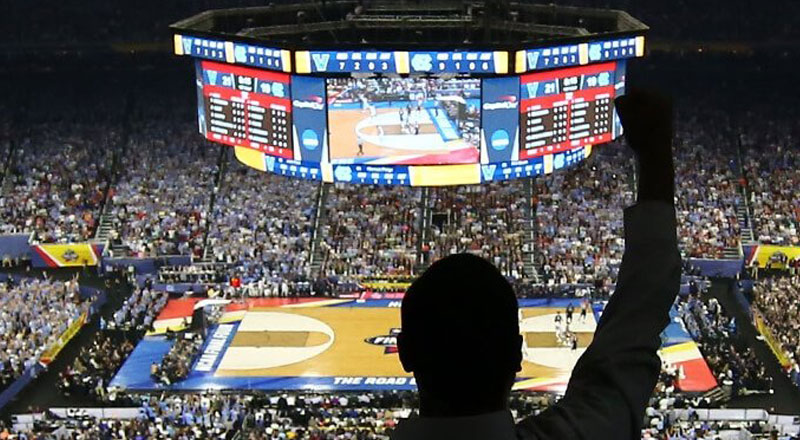Three Trends Shaping the Sports Industry
19-Apr-2018
“If you say we’re the problem, we’re the problem,” he says, adding that even though he had plans to improve the team, “nobody could see that. So you have to recognize that the fan’s always right.”
Lacob, who received an MBA from Stanford Graduate School of Business in 1983, spoke at the fifth annual Sports Innovation Conference, an all-day event held at Stanford GSB on March 7. Speakers discussed current issues in the industry, including the challenge of managing teams, connecting with fans, and using media to promote athletes and teams. The event, attended by about 800 people, was presented in partnership with Positive Coaching Alliance, a nonprofit based in Mountain View, California, that promotes character-building through youth participation in sports.
Elevating the Experience
Fan experience at games remains the highest priority, with traffic and parking at a stadium the perennial concerns. “If it’s a hassle, people will watch at home,” says Mike Golub, president of business of the Portland Timbers soccer club. Golub, who earned his MBA at Stanford GSB in 1988, added that he’s “intrigued” by the potential use of technology such as biometric recognition systems to speed up security.
New stadiums are under construction, such as the elaborate Chase Center in San Francisco for the Warriors, expected to be completed in 2019, with plans to offer an array of courtside lounges, club suites, and theater boxes, according to the stadium’s website. The planned Banc of California Stadium, a facility for the Los Angeles Football Club, will have fan suites on the field, 15 feet from the action, as well as a beach-style party space on the top level. At the same time, for the bulk of fans, “we need to keep the experience inclusive and affordable,” says Oakland Athletics President David Kaval, who earned his MBA in 2003 and lectures at Stanford GSB.
Technology can enhance the experience, especially for young spectators accustomed to mobile communications. In baseball, for instance, “with technology, we can teach where the game’s heading in a cool and exciting way because we can show the spin of a baseball” and let spectators see it from the batter’s point of view, says Jessica Mendoza, broadcaster for ESPN Sunday Night Baseball.
Don Garber, commissioner of Major League Soccer, says that the league has partnered with ad agency R/GA to develop new services such as transmitting game highlight clips, personalized to showcase a spectator’s favorite player, to a smartphone. Using technology to “provide ways that fans can engage is really the future of our business,” says Garber. “It’s no longer going to a sporting event with a hot dog and a beer and taking three and a half hours and driving home in the station wagon.”
Spreading the Word
The myriad of media that broadcasts, livestreams, posts, or otherwise distributes sports content is becoming only larger and more complex. Because major media firms have their own channels and also partner with YouTube, Facebook, and other social media sites, “we have all these technology platforms that are allowing us to speak directly to consumers” and present content efficiently, says Michael Spirito, who received his MBA from Stanford GSB in 2006. Spirito leads business development and digital media efforts at FOX Sports Regional Networks. “That’s accelerated over the last 15 to 18 months.”
The array of alternative platforms allows a huge quantity of content to be published quickly but doesn’t necessarily encourage depth in stories. “When I cover a game, they want a screaming headline,” says Ramona Shelburne, a senior writer for ESPN.com. “If I’m going to do something deep, I need to go pitch a separate project.”
Reporters are under constant pressure to post content on multiple channels. Indeed, Shelburne adds, one of the sports industry’s jobs of the future will be harnessing the huge amount of content that reporters and writers collect and editing it to run on the range of media platforms. And if reporters and writers are tech-savvy enough to make their own videos and reels and do other post-production work, then they’re that much better off, the panelists agreed.
Running the Show
Speakers discussed the challenges of owning and running a sports company, in which hard-nosed business skills, such as hiring, firing, and financial acumen, combine with the emotions of winning and losing. Being a good owner requires setting a vision for the organization, players, and fans, “and being relentless in the pursuit of winning,” says Lacob. “You need to feel what the fans feel 100%.”
Indeed, Major League Soccer and its supporters alike felt the pain when the U.S. team recently failed to qualify for the 2018 FIFA World Cup, says Garber. Yet he remains optimistic about the long-term success of soccer in the U.S., pointing to the growth of the Atlanta United FC team since its 2014 debut and its current average attendance of a substantial 50,000 people per game. The league as a whole has spent heavily to sign rising young stars and is redoubling efforts to identify and train homegrown talent from an early age. To produce world-class players is a “10-year deliverable,” Garber says.
For former baseball star Alex Rodriguez, founder and chief executive of investment and real estate firm A-Rod Corp., learning to run a company meant beginning at the starting line. “I had to develop my business fundamentals,” says Rodriguez, who played for the Seattle Mariners, Texas Rangers, and New York Yankees and was a 14-time All Star. One of his rookie mistakes: Not performing enough due diligence early and waiting until the “fourth or fifth inning” instead of “before the first pitch.”
Evaluating job candidates, “I’ve never hired anyone because of their degree,” he says. Rather, Rodriguez says, he scrutinizes an interviewee’s personality and determines whether he or she contributes to the dynamic and potential of the group. “Within five minutes, I know,” he says.
Source: www.gsb.stanford.edu











